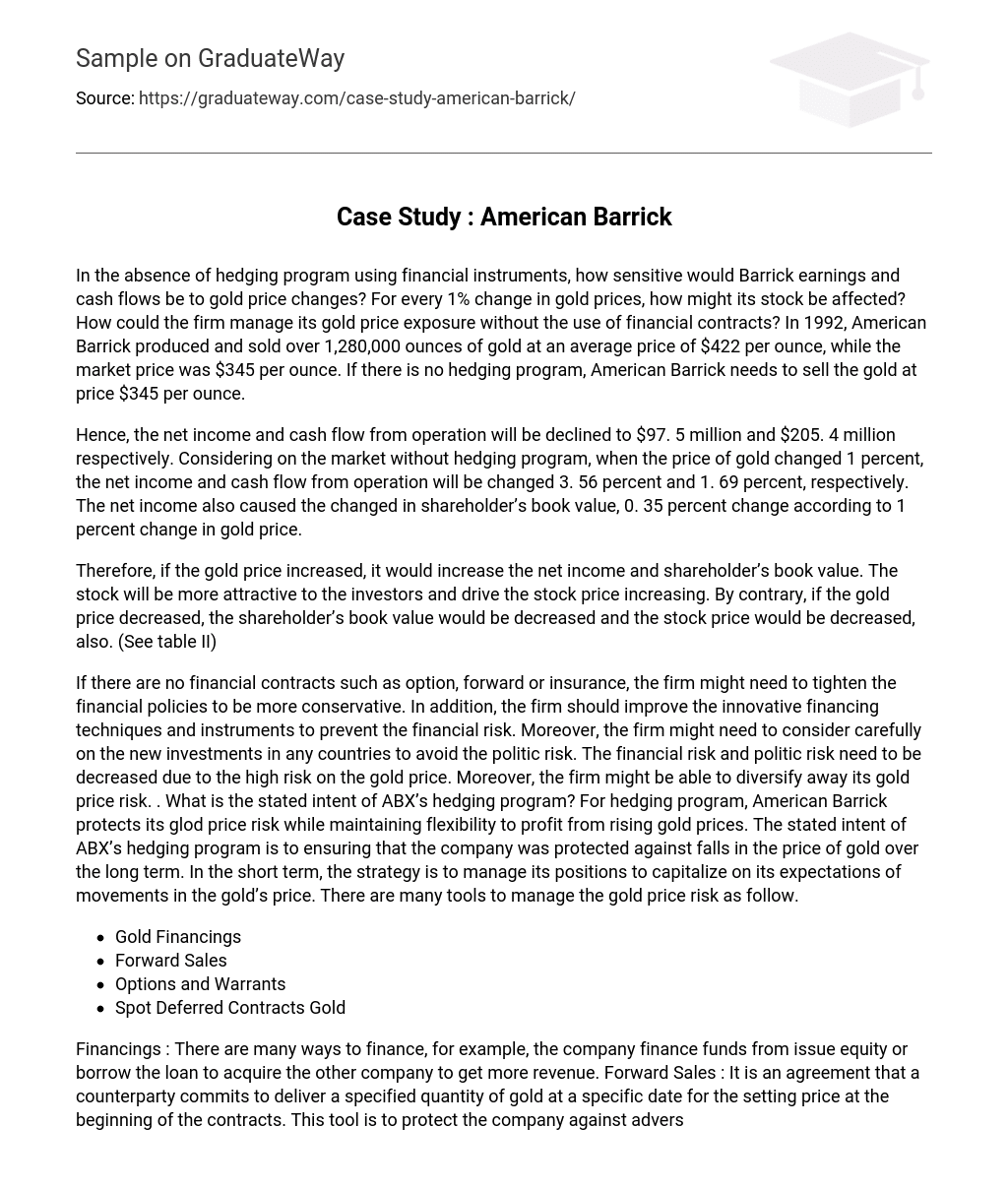In the absence of hedging program using financial instruments, how sensitive would Barrick earnings and cash flows be to gold price changes? For every 1% change in gold prices, how might its stock be affected? How could the firm manage its gold price exposure without the use of financial contracts? In 1992, American Barrick produced and sold over 1,280,000 ounces of gold at an average price of $422 per ounce, while the market price was $345 per ounce. If there is no hedging program, American Barrick needs to sell the gold at price $345 per ounce.
Hence, the net income and cash flow from operation will be declined to $97. 5 million and $205. 4 million respectively. Considering on the market without hedging program, when the price of gold changed 1 percent, the net income and cash flow from operation will be changed 3. 56 percent and 1. 69 percent, respectively. The net income also caused the changed in shareholder’s book value, 0. 35 percent change according to 1 percent change in gold price.
Therefore, if the gold price increased, it would increase the net income and shareholder’s book value. The stock will be more attractive to the investors and drive the stock price increasing. By contrary, if the gold price decreased, the shareholder’s book value would be decreased and the stock price would be decreased, also. (See table II)
If there are no financial contracts such as option, forward or insurance, the firm might need to tighten the financial policies to be more conservative. In addition, the firm should improve the innovative financing techniques and instruments to prevent the financial risk. Moreover, the firm might need to consider carefully on the new investments in any countries to avoid the politic risk. The financial risk and politic risk need to be decreased due to the high risk on the gold price. Moreover, the firm might be able to diversify away its gold price risk. . What is the stated intent of ABX’s hedging program? For hedging program, American Barrick protects its glod price risk while maintaining flexibility to profit from rising gold prices. The stated intent of ABX’s hedging program is to ensuring that the company was protected against falls in the price of gold over the long term. In the short term, the strategy is to manage its positions to capitalize on its expectations of movements in the gold’s price. There are many tools to manage the gold price risk as follow.
- Gold Financings
- Forward Sales
- Options and Warrants
- Spot Deferred Contracts Gold
Financings : There are many ways to finance, for example, the company finance funds from issue equity or borrow the loan to acquire the other company to get more revenue. Forward Sales : It is an agreement that a counterparty commits to deliver a specified quantity of gold at a specific date for the setting price at the beginning of the contracts. This tool is to protect the company against adverse price movements.
Options and Warrants : It is a tool that can mitigate the risk of price declines while allowing the firm to retain the benefit from the rising price. A collar is the strategy that buys put options and sells call option on gold. The exercise price of put is lower than call option, so the company can get premium. Spot Deferred Contracts (SDC) : It is a type of forward sale of gold that is an agreement of the forward seller delivers gold to the buyer at the forward price and at the setting date.
SDC has multiple delivery dates and the seller can rollover date of deliver that can be the premium. SDC is a way to profit from increases in the price of gold and can set the minimum price on its sales of gold. What should be the goal of a gold mine’s price risk management program? The goal of gold’s mine’s price risk management is to have stability in finance and to protect the impact of the fall in the gold price. Moreover, it allows the company to plan cash flows with confidence and help the company to raise the production and earnings of the firm in the future.
In addition the program can offers investors a predictable in the price of gold.
How would you characterize the evolution of Barrick’s price risk management activities?
Through the 1980s and early 1990s, as American Barrick’s reserves and financial strength improved and the market for gold-hedging vehicles matured, the company’s risk management activities grew in size and complexity. The firm used every instrument available to manage its gold price risk. At the beginning, American Barrick’s was tried to be a conservative firm.
While in short term, financial team tried to capitalize on its expectation of movement in the price of gold. Because of financial strength and good reserve base, financial team would like to use financial instrument. This resulted to being very expertise in using derivative. In late 1992, even gold price declined, American Barrick’s still made profit because of its skills of using contract. Are they consistent with the stated policy goals? As board set the guideline to be fully protected against price declines for all production out 3 years, and 20%-25% protected for the following decade.
- But the in practical, American Barrick’s did not follow its policy. See the following proves;
- Stopped adding new options positions in 1990 and used only spot deferred contract
- In 1992, with the historical low price for gold and interest rate, it could insure against gold prices falling below $432 but it stop adding option since 1990.
- It could also sold forward at $340. 86 for cash costs of $205, but it was not selling forward since 1990.
- So, American Barrick’s risk management involved substantial speculation.





